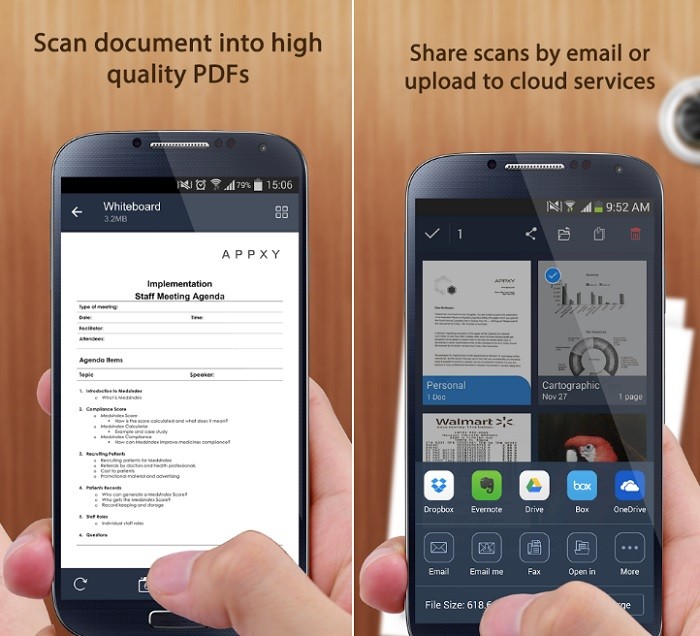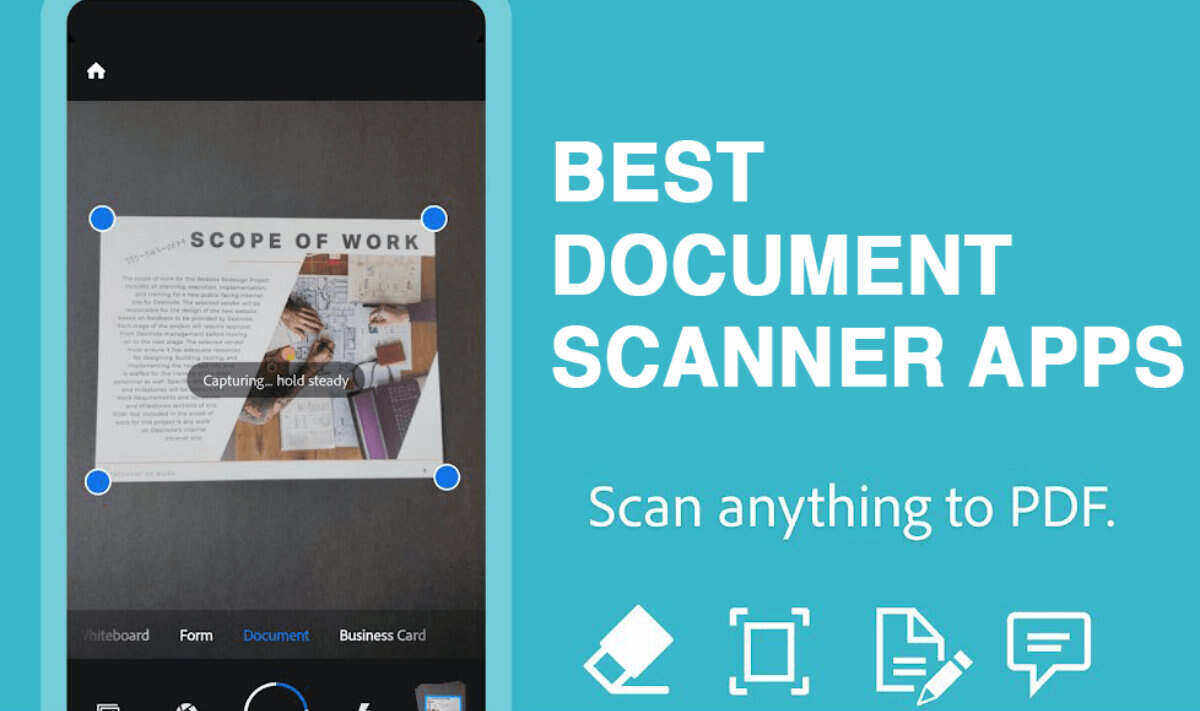Document scanning apps are transforming the way we manage and interact with documents, offering a plethora of benefits and revolutionizing document management practices.
These apps harness cutting-edge technologies to empower users with efficient document capture, organization, and sharing, streamlining workflows and enhancing productivity.
Document Scanning Apps
Document scanning apps are mobile applications that allow users to capture and digitize physical documents using their smartphone’s camera. These apps leverage optical character recognition (OCR) technology to extract text from scanned documents, making them searchable and editable.
Document scanning apps have gained immense popularity due to their convenience, efficiency, and cost-effectiveness. According to a study by Statista, the global document scanning apps market was valued at USD 2.4 billion in 2021 and is projected to reach USD 4.2 billion by 2026, growing at a CAGR of 10.5% during the forecast period.
Key Features and Capabilities
Document scanning apps offer a range of features and capabilities that enhance their functionality and user experience:
- OCR Technology:OCR technology enables document scanning apps to extract text from scanned documents, making them searchable and editable.
- Auto-cropping and Enhancement:These apps automatically crop and enhance scanned documents to remove unnecessary background and improve image quality.
- Document Management:Users can organize and manage scanned documents within the app, creating folders and applying tags for easy retrieval.
- Cloud Storage Integration:Many document scanning apps integrate with cloud storage services, allowing users to securely store and access their scanned documents from anywhere.
- Collaboration and Sharing:Apps facilitate collaboration by allowing users to share scanned documents with others via email, messaging, or social media.
Types of Document Scanning Apps

Document scanning apps can be broadly categorized based on their target audience. Each type of app offers unique features and use cases, catering to the specific needs of different user groups.
The primary categories of document scanning apps include those designed for individuals, businesses, and students.
For Individuals
Document scanning apps for individuals are designed to provide a convenient and efficient way to scan and manage personal documents. These apps typically offer features such as:
- Basic document scanning capabilities
- OCR (optical character recognition) for text extraction
- Document editing and annotation tools
- Cloud storage integration
- File sharing and collaboration features
Popular examples of document scanning apps for individuals include CamScanner, Adobe Scan, and Microsoft Lens.
For Businesses
Document scanning apps for businesses are designed to meet the specific needs of organizations and professionals. These apps offer advanced features such as:
- High-volume scanning capabilities
- Batch processing and automation
- Integration with business applications
- Enhanced security features
- Document workflow management tools
Popular examples of document scanning apps for businesses include Kofax Power PDF, ABBYY FineScanner, and PaperPort.
For Students
Document scanning apps for students are designed to provide a convenient and cost-effective way to scan and manage academic materials. These apps typically offer features such as:
- Specialized scanning modes for textbooks and notes
- OCR for text extraction and highlighting
- Annotation and collaboration tools
- Integration with educational platforms
- Cloud storage and backup
Popular examples of document scanning apps for students include Scannable, Genius Scan, and Notebloc.
Features and Functionality
Document scanning apps offer a range of features that enhance productivity and streamline document management.Core features include image capture and enhancement, optical character recognition (OCR), document organization and management, and collaboration and sharing.
Image Capture and Enhancement
Document scanning apps use advanced algorithms to capture clear and accurate images of documents. Features like auto-cropping, perspective correction, and image enhancement ensure that scanned documents are legible and easy to work with.
Optical Character Recognition (OCR)
OCR technology enables document scanning apps to extract text from scanned documents. This allows users to search, edit, and copy text from scanned documents, making them easily accessible and editable.
Document Organization and Management
Document scanning apps provide robust document management capabilities. Users can organize scanned documents into folders, tag them with s, and perform advanced searches to quickly retrieve specific documents.
Collaboration and Sharing, Document scanning apps
Document scanning apps facilitate collaboration and sharing of scanned documents. Users can easily share documents with colleagues, clients, or partners via email, cloud storage, or messaging apps.
Benefits and Use Cases

Document scanning apps offer numerous benefits that enhance productivity, organization, collaboration, and environmental sustainability.
Increased Efficiency and Productivity
By eliminating the need for manual scanning and filing, document scanning apps streamline document management processes, saving time and reducing errors. Optical character recognition (OCR) technology enables easy text search within scanned documents, facilitating quick retrieval and analysis.
Improved Document Organization and Accessibility
Scanning documents digitally creates a centralized repository, making it easier to organize, categorize, and retrieve documents. Cloud storage options provide remote access to scanned documents from any device, improving accessibility and collaboration.
Enhanced Collaboration and Document Sharing
Document scanning apps facilitate seamless document sharing and collaboration. Scanned documents can be easily shared with colleagues, clients, or partners, enabling efficient communication and document review.
Reduced Paper Waste and Environmental Impact
Digitizing documents significantly reduces paper consumption, minimizing paper waste and contributing to environmental sustainability. Electronic storage eliminates the need for physical filing cabinets, freeing up office space and reducing clutter.
Challenges and Limitations
Document scanning apps, while offering numerous benefits, are not without their challenges and limitations. These include:
- Accuracy of OCR:Optical Character Recognition (OCR) technology used in document scanning apps may not always be 100% accurate, especially when dealing with complex or handwritten documents.
- File size and storage limitations:Scanned documents can be large in size, especially high-resolution images. This can lead to storage limitations on devices or cloud services.
- Security concerns:Document scanning apps often require access to sensitive information, such as financial documents or personal identification. Ensuring the security of this data is crucial.
- User interface and learning curve:Some document scanning apps may have complex user interfaces or require a learning curve, which can hinder user adoption and efficiency.
Strategies to Overcome Challenges
To overcome these challenges and improve the overall user experience, several strategies can be employed:
- Accuracy of OCR:Developers can utilize advanced OCR algorithms and machine learning techniques to enhance the accuracy of text recognition, even for complex documents.
- File size and storage limitations:Implementing compression algorithms or offering cloud storage options can help reduce file sizes and alleviate storage concerns.
- Security concerns:Employing encryption, multi-factor authentication, and adhering to industry-standard security protocols can ensure the protection of sensitive data.
- User interface and learning curve:Providing intuitive user interfaces, clear instructions, and tutorials can reduce the learning curve and improve user adoption.
Trends and Future of Document Scanning Apps
The document scanning app industry is constantly evolving, with new trends and technologies emerging all the time. Some of the most notable trends include:
- The rise of artificial intelligence (AI) and machine learning (ML): AI and ML are being used to automate many of the tasks that were previously done manually by humans, such as document recognition, data extraction, and image enhancement. This is making document scanning apps more accurate, efficient, and user-friendly.
- The increasing popularity of cloud-based document scanning apps: Cloud-based document scanning apps allow users to store and access their scanned documents from anywhere, on any device. This is making it easier for people to collaborate on documents and share them with others.
- The development of new features and functionality: Document scanning apps are constantly being updated with new features and functionality, such as the ability to scan multiple documents at once, create PDFs, and add annotations. This is making document scanning apps more versatile and useful than ever before.
In the future, we can expect to see even more innovation in the document scanning app industry. AI and ML will continue to play a major role in the development of new features and functionality. We can also expect to see the emergence of new technologies, such as augmented reality (AR) and virtual reality (VR), that will further enhance the user experience.
Impact of Artificial Intelligence (AI) and Machine Learning (ML) on Document Scanning Apps
AI and ML are having a major impact on the document scanning app industry. These technologies are being used to automate many of the tasks that were previously done manually by humans, such as document recognition, data extraction, and image enhancement.
This is making document scanning apps more accurate, efficient, and user-friendly.One of the most significant ways that AI and ML are being used in document scanning apps is for document recognition. AI-powered document recognition algorithms can automatically identify the type of document being scanned, such as a receipt, invoice, or contract.
This information can then be used to automatically extract data from the document, such as the date, amount, and vendor.AI and ML are also being used to improve the accuracy of document scanning apps. By training AI algorithms on large datasets of scanned documents, developers can create apps that can accurately scan even complex or damaged documents.In addition, AI and ML are being used to develop new features and functionality for document scanning apps.
For example, some apps now allow users to search for specific text within scanned documents. Others allow users to annotate scanned documents with notes and highlights.The impact of AI and ML on the document scanning app industry is still evolving.
However, it is clear that these technologies are playing a major role in making document scanning apps more accurate, efficient, and user-friendly.
Final Summary

As technology continues to advance, document scanning apps will undoubtedly evolve, integrating AI and ML to further enhance their capabilities. They will become indispensable tools for individuals and businesses alike, empowering us to manage our documents effortlessly and efficiently.
FAQ Resource
How accurate is OCR in document scanning apps?
OCR accuracy has significantly improved in recent years, with many apps offering high levels of accuracy. However, factors such as document quality and complexity can affect accuracy.
What are the security concerns associated with document scanning apps?
Security is a crucial consideration. Look for apps that employ encryption and other security measures to protect sensitive data.
Can document scanning apps help me reduce paper waste?
Yes, by digitizing documents, you can significantly reduce paper consumption, promoting a more environmentally friendly approach.
